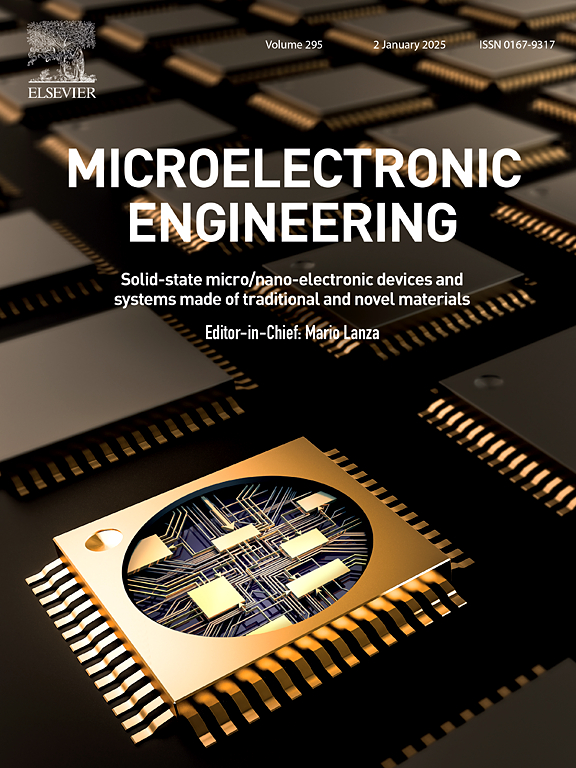High-performance copper-seed-layer deposition using 60-MHz high-frequency–direct current superimposed magnetron sputtering
IF 3.1
4区 工程技术
Q2 ENGINEERING, ELECTRICAL & ELECTRONIC
引用次数: 0
Abstract
This study aims to demonstrate the deposition of high-performance Cu-seed layers using a very high frequency–direct current (VHF–DC) superimposed magnetron sputtering system for sub-20-nm dual-damascene interconnects. Plasma diagnostics revealed substantial improvements in plasma properties with electron densities measured at ne ≈ 1.71 × 1016 m−3 for direct current magnetron sputtering (DCMS), ne ≈ 3.08 × 1016 m−3 for 40.68 MHz VHF–DC, and ne ≈ 1.63 × 1017 m−3 for 60 MHz VHF–DC. These enhancements enabled superior step coverage and thin-film uniformity, particularly in high-aspect-ratio structures, achieving a bottom-to-top coverage ratio exceeding 100 % at an RF bias of 200 W. Comparative analysis using X-ray diffraction and X-ray photoelectron spectroscopy showed that Cu![]() Mn films deposited via VHF–DC superimposed sputtering exhibited improved Cu (111) crystallinity, reduced void formation, and enhanced adhesion compared to conventional DCMS. These findings reveal VHF–DC superimposed sputtering as a critical technological advancement, offering enhanced process reliability and scalability for next-generation semiconductor devices.
Mn films deposited via VHF–DC superimposed sputtering exhibited improved Cu (111) crystallinity, reduced void formation, and enhanced adhesion compared to conventional DCMS. These findings reveal VHF–DC superimposed sputtering as a critical technological advancement, offering enhanced process reliability and scalability for next-generation semiconductor devices.

采用60 mhz高频直流叠加磁控溅射技术制备高性能铜种子层
本研究旨在展示使用甚高频直流(VHF-DC)叠加磁控溅射系统沉积高性能铜籽层,用于亚20纳米双damascene互连。等离子体诊断显示等离子体性能有了实质性的改善,直流磁控溅射(DCMS)的电子密度为ne≈1.71 × 1016 m−3,40.68 MHz VHF-DC的电子密度为ne≈3.08 × 1016 m−3,60 MHz VHF-DC的电子密度为ne≈1.63 × 1017 m−3。这些增强实现了卓越的阶跃覆盖和薄膜均匀性,特别是在高纵横比结构中,在200w的RF偏置下实现了超过100%的自下而上覆盖率。通过x射线衍射和x射线光电子能谱的对比分析表明,与传统的DCMS相比,VHF-DC叠加溅射沉积的CuMn薄膜具有更高的Cu(111)结晶度、更少的孔洞形成和更强的附着力。这些发现表明,VHF-DC叠加溅射是一项关键的技术进步,为下一代半导体器件提供了更高的工艺可靠性和可扩展性。
本文章由计算机程序翻译,如有差异,请以英文原文为准。
求助全文
约1分钟内获得全文
求助全文
来源期刊

Microelectronic Engineering
工程技术-工程:电子与电气
CiteScore
5.30
自引率
4.30%
发文量
131
审稿时长
29 days
期刊介绍:
Microelectronic Engineering is the premier nanoprocessing, and nanotechnology journal focusing on fabrication of electronic, photonic, bioelectronic, electromechanic and fluidic devices and systems, and their applications in the broad areas of electronics, photonics, energy, life sciences, and environment. It covers also the expanding interdisciplinary field of "more than Moore" and "beyond Moore" integrated nanoelectronics / photonics and micro-/nano-/bio-systems. Through its unique mixture of peer-reviewed articles, reviews, accelerated publications, short and Technical notes, and the latest research news on key developments, Microelectronic Engineering provides comprehensive coverage of this exciting, interdisciplinary and dynamic new field for researchers in academia and professionals in industry.
 求助内容:
求助内容: 应助结果提醒方式:
应助结果提醒方式:


